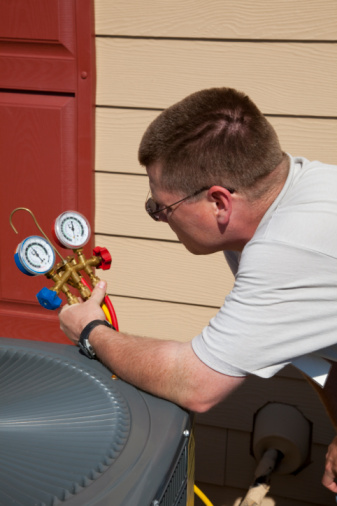According to the most recent Residential Energy Consumption Survey, a full 87 percent of U.S. households are equipped with air conditioning. This number is up from 60 percent at the beginning of the 1990s. According to the same survey, central air conditioning outpaces window units as the system of choice in all parts of the United States, except for the Northeast part of the country. A growing number of residences with window units end up retrofitted for central air each and every year.
Freon, the gas utilized as the coolant in most home air conditioning systems, does not retain its effectiveness indefinitely. Over time, Freon loses its charge and, as a result, its cooling ability. A homeowner needs to become aware of some of the telltale signs that a central air conditioner needs charged.
The Basic Test: Checking Thermostat
The first step a person takes in determining whether there is a need to get Freon charged is examining the thermostat. A basic test is recommended by the Environmental Protection Agency (which is concerned with home heat and air conditioning efficiency).
A homeowner sets the thermostat at 65 degrees and activates the air conditioning system. If the room temperature reading on thermostat does not drop within 15 minutes, the need for a Freon may exist.
Checking the Air Conditioner Out Flow
A companion test to checking thermostat is physically checking the air being emitted from the out flow vent when the air conditioning system is activated. A homeowner needs to keep in mind that the thermostat may be malfunctioning and not providing an accurate room temperature reading.
A person places a hand over the out flow vent while the system is running to physical feel if the air feels cool. If the air feels about the same temperature as the surrounding room air, this represents another sign that a charging is necessary.
Eliminate Other Potential Issues
The process of determining whether Freon should be charged also needs to incorporate the elimination of other potential problems that may be impeding the flow of cool air. For example, when checking the air flow at the vent, attention must be paid as to whether the movement from the vent is consistent and strong. If the air flow is uneven or weak, there may exist an issue with the fan or motor associated with the air conditioner. If there is no air movement at all, the motor may have burned out.
Professional Gauge Reading
After performing these preliminary examinations, the only real way a consumer can confirm that a Freon charge is necessary is seeking professional assistance. A heating and air conditioning professional utilizes a gauge that tests the level of charge of the Freon gas in a central air conditioning system.
Absent this type of professional testing of an air conditioning system, a homeowner may misdiagnose the problem. A homeowner may needless spend money having a certain service performed on a central air system when something entirely different needed to be undertaken. If a recharging is necessary, a professional can undertake the process efficiently and with minimal interruption to the use of the central air system.

